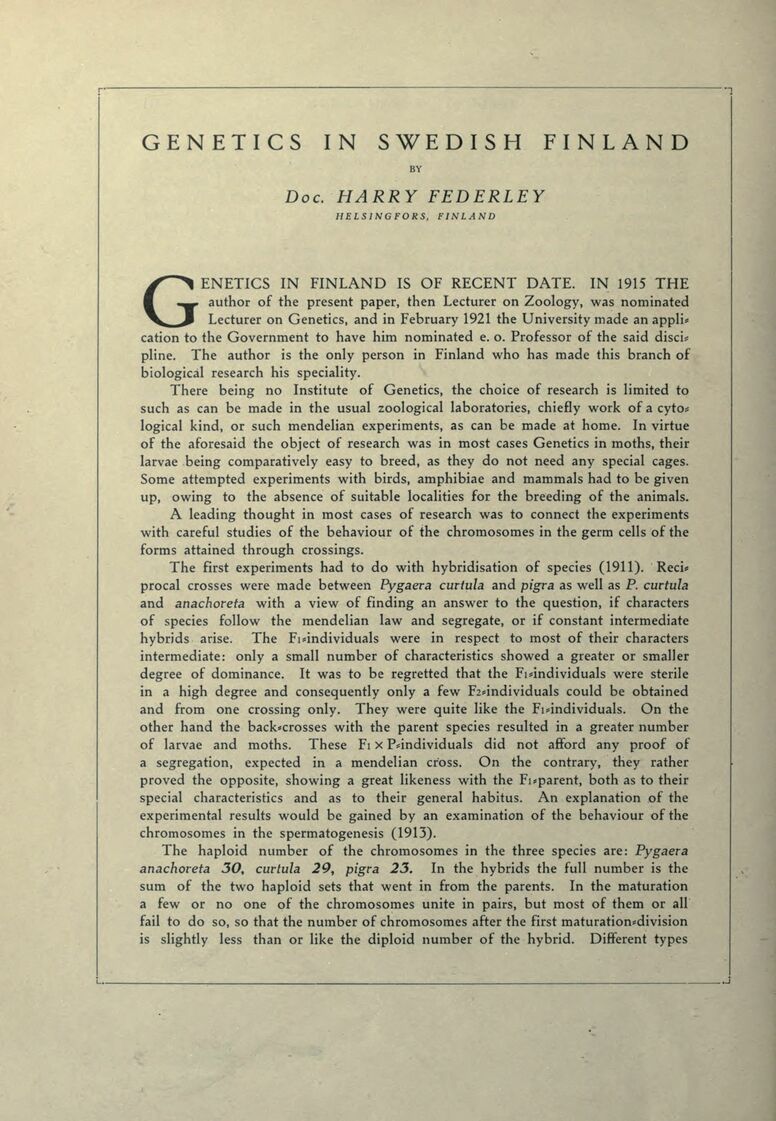
Full resolution (JPEG) - On this page / på denna sida - Part I - Docent Harry Federley, Helsingfors, Genetics in Swedish Finland

<< prev. page << föreg. sida << >> nästa sida >> next page >>
Below is the raw OCR text
from the above scanned image.
Do you see an error? Proofread the page now!
Här nedan syns maskintolkade texten från faksimilbilden ovan.
Ser du något fel? Korrekturläs sidan nu!
This page has never been proofread. / Denna sida har aldrig korrekturlästs.
GENETICS IN SWEDISH FINLAND
BY
Doc. HARRY FEDERLEY
HELSINGFORS, FINLAND
Genetics in finland is of recent date. in 1915 the
author of the present paper, then Lecturer on Zoology, was nominated
Lecturer on Genetics, and in February 1921 the University made an appli*
cation to the Government to have him nominated e. o. Professor of the said discis
pline. The author is the only person in Finland who has made this branch of
biologicäl research his speciality.
There being no Institute of Genetics, the choice of research is limited to
such as can be made in the usual zoological laboratories, chiefly work of a cyto*
logical kind, or such mendelian experiments, as can be made at home. In virtue
of the aforesaid the object of research was in most cases Genetics in moths, their
larvae being comparatively easy to breed, as they do not need any special cages.
Some attempted experiments with birds, amphibiae and mammals had to be given
up, owing to the absence of suitable localities for the breeding of the animals.
A leading thought in most cases of research was to connect the experiments
with careful studies of the behaviour of the chromosomes in the germ cells of the
forms attained through crossings.
The first experiments had to do with hybridisation of species (1911). Reci*
procal crosses were made between Pygaera curtula and pigra as well as P. curtula
and anachoreta with a view of finding an answer to the question, if characters
of species follow the mendelian law and segregate, or if constant intermediate
hybrids arise. The Fi=individuals were in respect to most of their characters
intermediate: only a small number of characteristics showed a greater or smaller
degree of dominance. It was to be regretted that the Fidndividuals were sterile
in a high degree and consequently only a few F2*individuals could be obtained
and from one Crossing only. They were quite like the Fidndividuals. On the
other hånd the back*crosses with the parent species resulted in a greater number
of larvae and moths. These Fi x Pdndividuals did not afford any proof of
a segregation, expected in a mendelian cross. On the contrary, they rather
proved the opposite, showing a great likeness with the Fi^parent, both as to their
special characteristics and as to their general habitus. An explanation of the
experimental results would be gained by an examination of the behaviour of the
chromosomes in the spermatogenesis (1913).
The haploid number of the chromosomes in the three species are: Pygaera
anachoreta 30, curtula 29, pigra 23. In the hybrids the full number is the
sum of the two haploid sets that went in from the parents. In the maturation
a few or no one of the chromosomes unite in pairs, but most of them or all
fail to do so, so that the number of chromosomes after the first maturatiomdivision
is slightly less than or like the diploid number of the hybrid. Different types
<< prev. page << föreg. sida << >> nästa sida >> next page >>